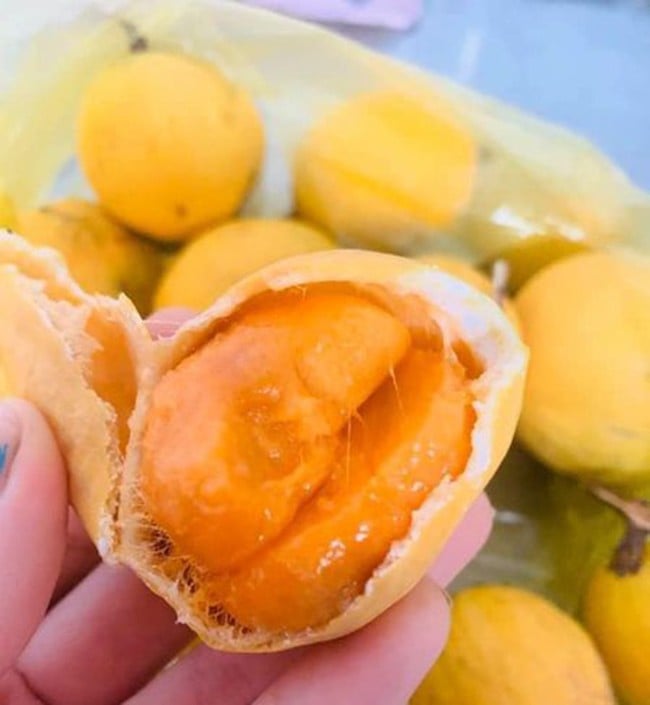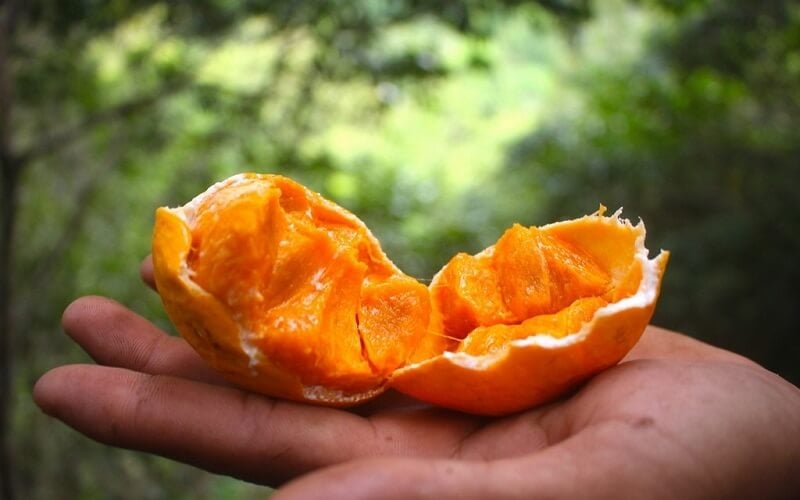From the Deep An Giang Forests to City Dining Tables
An Giang, renowned for its tram, truong, and bon bon fruits, also harbors a unique “secret” known as the gui fruit. This wild fruit grows abundantly in the old forests, especially on mountain slopes. When ripe, the gui fruit’s outer shell transforms into a golden hue, resembling a round, plump shape that could be mistaken for a leki ma fruit.
Each gui fruit, when cut open, reveals a deep yellow flesh divided into segments like a jackfruit, offering a delightful blend of sweet and sour flavors. It leaves a lingering, distinctive fragrance, making it a refreshing treat for locals during the hot season. Little did they know that this seemingly casual snack would one day become a coveted delicacy in urban areas.

Gui—A Unexpectedly “Hunted” Delicacy in the City
Only in recent years, as culinary enthusiast groups began sharing images of the gui fruit online, did it capture the attention of discerning foodies in the city. With its unique appearance, intriguing flavor, and strong connection to the ancient forests, gui quickly became a sought-after delicacy, almost like a “fruit that tells a story.”
In wholesale markets and specialty shops, fresh gui fruit fetches a price of 100,000–150,000 VND/kg, double or triple the price in the growing regions. Even at this premium, supply often falls short of demand. As shared by Ms. Hong, a specialty shop owner in District 3, Ho Chi Minh City, “Gui is an unusual fruit that has captivated many customers. Those who have tried it always come back for more, especially during hot weather.”
How to Fully Appreciate the Flavor of Gui Fruit?
Ripe gui fruit can be enjoyed directly or blended into a refreshing smoothie with ice and a touch of sugar. For a creative twist, combine gui with yogurt and chia seeds to make a delicious and healthy dessert.
However, it’s important to note that unripe gui fruit is not edible due to its bitter taste and the presence of latex. When purchasing, choose fruits with a uniform golden color, a soft texture, and a subtle fragrant aroma. Gui can be stored at room temperature for 2–3 days or in the refrigerator for up to a week.

Reviving a Native Delicacy
The resurgence of the gui fruit brings joy not only to food enthusiasts but also opens up new opportunities for mountain communities:
- Additional income source from natural forests: During the season, locals can harvest 5–10 kg of gui fruit daily and sell it directly to traders in the forest.
- Unleashing the potential of local specialties: Efforts are being made to research controlled propagation methods and establish more stable cultivation areas for gui.
- Boosting eco-tourism: Groups of young people are organizing tours to explore the gui forests, offering a unique experience of harvesting and tasting the ripe fruit on-site.
Natural food expert Nguyen Bich Ha shared, “Gui is a vivid example that demonstrates how a specialty doesn’t need to be extravagant. By preserving its natural flavor and sharing its story, it can capture the hearts of modern consumers.”
Conclusion
Emerging from the depths of An Giang’s forests, the gui fruit is steadily establishing its place in the Vietnamese specialty market. Beyond its unique flavor, gui evokes a connection to the wild, untamed nature and conveys a sense of sincerity and warmth akin to its sweet and sour taste. Those who have had the pleasure of tasting it are unlikely to forget this delightful fruit anytime soon.
The Breathtaking Natural Rock Park in Ninh Thuan: A Majestic Wonder Crafted by Mother Nature Herself
The Ninh Thuan National Park has been recognized by UNESCO as a World Biosphere Reserve. This diverse landscape, boasting forests, seas, mountains, and a semi-desert, attracts tourists from far and wide. The majestic mountains, in particular, captivate visitors with their Mediterranean-esque vistas.
“The World’s Best Tourism Village” in Vietnam is Flooded with Wonders: From Majestic Caves to Rustic Delicacies
Tan Hoa is the only Vietnamese village that has been selected by UNWTO in the list of 260 villages from 60 participating countries for the 2023 award. During the recent Storm No. 4, hundreds of houses in the village were submerged in deep water. At times, the floodwaters rose as high as 2 meters, completely isolating Tan Hoa from the outside world.
The Ultimate Guide to 5 Luxurious Homestays in Thanh Hoa: A Magical Experience You Won’t Want to Leave
If you’re seeking an escape from the hustle and bustle of daily life, immerse yourself in the breathtaking beauty of Thanh Hoa. This idyllic destination offers a tranquil retreat and a chance to explore its captivating landscapes. Discover the best homestays in Thanh Hoa, where cozy accommodations meet the awe-inspiring wonders of nature. Unwind, relax, and embark on a journey of exploration in this enchanting locale.














